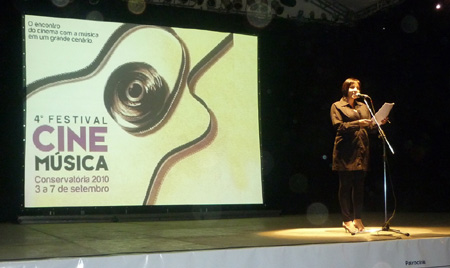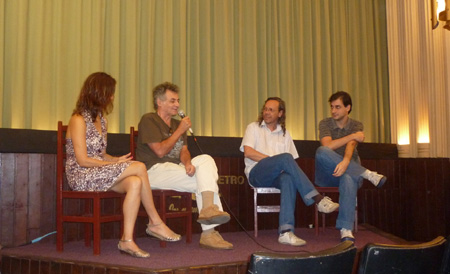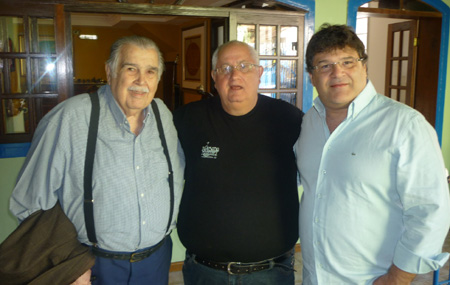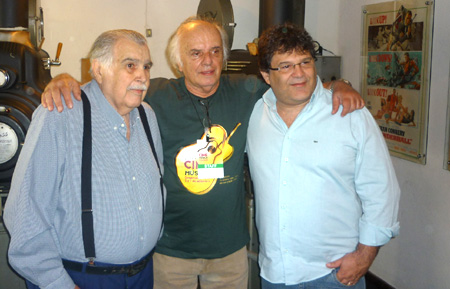A tribute to Incol and its owner in a Brazilian Film Festival | Read more at in70mm.com The 70mm Newsletter |
| Written & photographed by: Paulo Roberto P. Elias, Rio de Janeiro, Brazil | Date: 13.09.2010 |
.jpg) Day view of the imposing Metro-Tijuca replica, in Conservatória. Day view of the imposing Metro-Tijuca replica, in Conservatória.Each year, for the last three years, the small city of Conservatória, 145 km away from the Rio de Janeiro centre, on its mountain side, holds a film and music festival, called Festival Cinemúsica. This year, they had its 4th incarnation. In such events a significant number of filmmakers, business men, musicians, and the general public are gathered to enjoy, discuss and sometimes talk privately about the trades of the business. But the Festival is also concerned to pay homage to individuals who have previously contributed to the industry, technically and artistically wise. | More in 70mm reading: Mr. Orion Jardim de Faria - A visit to a Brazilian 70mm film Pioneer Large Format in Brazil / 70mm In Rio The Incol 70-35 projector Internet link: Brazilian text Conservatória Festival Cinemúsica |
Some titbits about the town | |
.jpg) The Metro theater replica, prior to its evening opening to tourists. The Metro theater replica, prior to its evening opening to tourists.Conservatória is very hospitable and filled with several small to medium sized inns, what the locals call “pousadas”. Once you lodge yourself in one of those places, you can turn to the Festival immediately, and maybe because it is a peaceful space, time seems to stop while you are there! Traditionally, the town has a music concert in its main streets every night, but as far as film is concerned people will have to rely on the initiatives of Mr. Ivo Raposo, a lawyer who is passionate about film matters and who worked in his youth in more than one cinema booth in Rio. Mr. Raposo built a small scale replica of the Metro-Tijuca, which was no small task, given that the building was demolished in 1977. Several original decorative pieces, the screen, and even the projectors were salvaged by him for several years. | |
.jpg) An evening at the theater: remembrances of the good old days of the Metro theater An evening at the theater: remembrances of the good old days of the Metro theaterThe replica impresses so many visitors, to the extent that is not unusual to see people with tears in their eyes when they first approach it. Many generations frequented the original Metro-Tijuca. The original theater was the second of its kind in Rio, and it provided technical excellence in one luxurious installation until it was closed down. | |
 Grand opening of the 4th Cinemúsica, at its main stage, located at the town’s square. Grand opening of the 4th Cinemúsica, at its main stage, located at the town’s square.During the Festival, the visitor is offered a good taste of its gastronomic flavours, with a special place reserved (no pun intended) for the locally produced liquor, which is popularly called “cachaça”. This alcoholic beverage is produced from sugar cane, but in this particular case it is carefully distilled twice, in order to yield a smoother taste and relatively purer alcohol content. It is also custom made for the local inns, but visitors are free to taste a sample and buy it if they wish to do so. | |
A thorough discussion about current film making status | |
 From left to right: film directors Marcia Derraik and Tom Job Azulay (holding the mike and opening the day’s debates), the Festival’s curator Hernani Heffner and film director Renato Terra. From left to right: film directors Marcia Derraik and Tom Job Azulay (holding the mike and opening the day’s debates), the Festival’s curator Hernani Heffner and film director Renato Terra.One of the purposes of the Festival is to gather film makers, producers and exhibitors, to discuss and hopefully offer new perspectives for the Brazilian film industry. These debates take place in small sessions, once a day, with specific themes, during the course of the Festival. | |
_west.jpg) I was in one of those, and I could quickly realize why it was so important to put specific problems on the table, and listen to the film makers experience with them. On the production side, independent film makers carry the heaviest burden. And after the film is made, there is also an important issue to resolve, which is its distribution to theaters. Not only there has been a significant reduction in seats all over the country but also the number of films being made is greater and in excess of the offerings made by exhibitors. This ultimately means that a great number of finished projects will not see the light of day in theaters. As part of these discussions film makers and producers will contemplate all possible ways to reach the public. I was in one of those, and I could quickly realize why it was so important to put specific problems on the table, and listen to the film makers experience with them. On the production side, independent film makers carry the heaviest burden. And after the film is made, there is also an important issue to resolve, which is its distribution to theaters. Not only there has been a significant reduction in seats all over the country but also the number of films being made is greater and in excess of the offerings made by exhibitors. This ultimately means that a great number of finished projects will not see the light of day in theaters. As part of these discussions film makers and producers will contemplate all possible ways to reach the public.One of these ways may very well be video. Modern shooting processes will include a digital camera, and computer-based editing methods. Once the digital intermediate is made, producers and directors can decide which destiny the film will take. If it is video, DVD or Blu-Ray are the main targets. | |
A tribute to a 70 mm film pioneer by his peers | |
 From left to right: 70 mm film pioneer Orion de Faria, former senior fox executive Sebastião Martinez, and film exhibitor Leonardo de Faria, Orion’s son. From left to right: 70 mm film pioneer Orion de Faria, former senior fox executive Sebastião Martinez, and film exhibitor Leonardo de Faria, Orion’s son.I have previously described my visit to Orion Jardim de Faria, owner, designer, and manufacturer of the Incol 70/35 projector. This year, the 4th Cinemúsica decided to pay him a tribute and recall Mr. de Faria’s memory in front of the public and letting him be honoured by his peers. It was a happy coincidence that one of former Fox Films senior directors, Mr. Sebastião Martinez, is also the owner of one of the best local pousadas. Mr. Orion de Faria and his son Leonardo de Faria were lodged in the Martinez place, and as a result a lot of recollection of those glorious 70 mm days went on between them. | |
 From left to right: Orion de Faria, Ivo Raposo (the president of the Festival organizing committee), and Leonardo de Faria, posing for the recording staff, in one of the projection booths From left to right: Orion de Faria, Ivo Raposo (the president of the Festival organizing committee), and Leonardo de Faria, posing for the recording staff, in one of the projection boothsI was told by Mr. Martinez that during his heydays at Fox he was responsible for importing the largest share of prints for 70 mm exhibition. In those days Titra Films, the company responsible for most 35 mm subtitling did not have means to do the same on 70 mm prints. Thus, importers had to subtitle their copies in the US, prior to getting them to theaters. Sadly, I was also told by Mr. Martinez that all 70 mm prints were destroyed, which prevents any possible revival festival. Had they survived, we would probably have no idea about fading conditions of those prints. The tribute to Mr. Orion de Faria for his exquisite work was conducted as an interview, done by the Festival’s curator, Mr. Hernani Heffner, who is also a scholar on film technology and works as preservation director for Rio’s Museum of Modern Art filmothèque. | |
.jpg) Mr. Hernani Heffner (left) listening to Orion de Faria’s life testimony, during his tribute. Mr. Hernani Heffner (left) listening to Orion de Faria’s life testimony, during his tribute.The interview went on for almost a couple of hours, and later the public had a chance to participate. It is true that a small number of theaters are still running with those Incol projectors, and in most cases trouble-free as described by people who went to the meeting. The interview was recorded on tape, for posterity. At this point, I am not sure that it will be readily available to the general public. I must say that I was particularly happy with this tribute, because it was done by people in the film industry, and not by an ignoble writer and fan like yours truly. A lot of the youngest had no idea of Orion’s participation in the former 70 mm exhibition market, but since, until recently, I had no idea myself either, that perception was not at all surprising. It was, nevertheless, by all means a pleasant stay over the week end that I was there, meeting people, and getting to know the successes and difficulties of the film industry. | |
| Go: back - top - back issues - news index Updated 22-01-25 |
